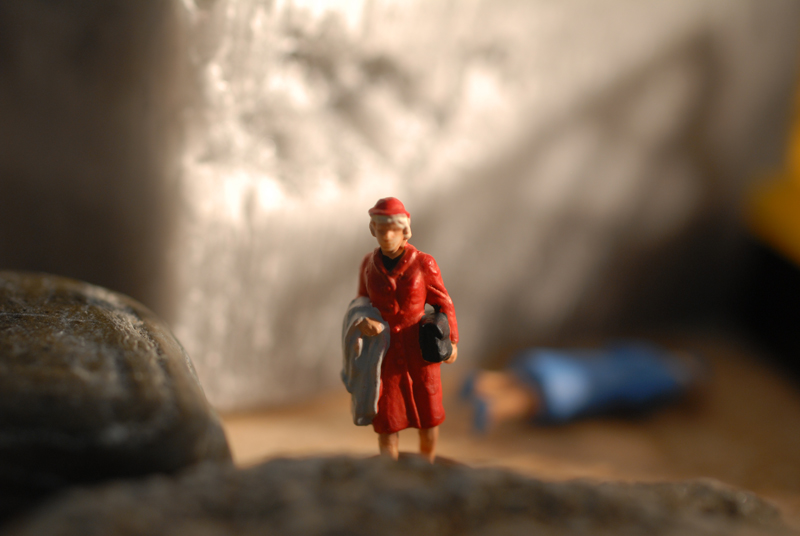Pink Slime, Zuccotti Park, and a little Led Zep
I spent most of Sunday helping to hang the new group show at Viridian Artists, on W. 28th St., juried by Chrissie Iles, a curator at the Whitney Museum of American Art. It was interesting to watch her silently visualize how each piece would look, deep in thought, while the rest of us moved pieces from one wall and to another and then often back onto the original wall, at her request. She required the center of each piece to be exactly 57” above the floor, so I helped Bob Mielenhausen, a fellow Viridian artist, in measuring each one, then bisecting it with a little plastic dot sticker. We then held up each painting to align the sticker with a levelled mark running along the wall at that height. It was something I’d never thought to do before: having the center of every work at exactly the same height in relationship to the floor and the viewer’s eye. No doubt it’s the most elementary rule in the curatorial book, but it was nice to finally learn it. It really made a difference in the look of the whole show when we were done.
As all of this went on, Chrissie was sensitive to distractions. “I don’t want to see those phones,” she said at one point, referring to a diptych involving a cell phone and a more traditional handset. So I would move them out of her sight. Same with a couple other paintings that seemed to keep getting shunted off to some place out of view. I was beginning to feel their pain. I’ve been ostracized; I know what it’s like. Finally, though, she would hit on the exact spot for a particular work and up it went, never to be reconsidered. Those seemingly neglected phones, in fact, were the first to find their home, long before everything else in the show. But for a long time, it was, “Just move that one somewhere else.”
She specializes in film, as well as film and video installation, and Minimalist and process-based art of the sixties and seventies. She is part of the curatorial team formulating the overall artistic policy of the Whitney Museum. For our day’s work, I joined our director, Vernita Nemec, her assistant director, Lauren Purje, and Bob. It took us six hours, from start to finish, with an hour break for brunch at the Half King a couple blocks away, where you get free Bloody Marys with your meal, their tomato juice loaded with bits of shrimp and hot sauce. When Chrissie came back from a long phone call from Europe, she started telling us about her close friend, the legendary international performance artist, Marina Abromovic.
“I’m currently writing the text for a book on her performances. I did her first retrospective at Oxford,” she said, giving us a lot of background about how close the Abromovic family was with Tito in Yugoslavia, before it broke apart along ethnic lines. “The key to a lot of her work was her mother. Really rigid woman. Really awful.”
I wanted to hear a lot more, but our conversation was kept short by her long conference call with Europe and the need to finish hanging the show. Whan we got back to the gallery, the level of care she continued to put into every detail of our group effort impressed me enormously. The work was of varying quality, with many well-realized pieces that stood out, and she was careful to present them as they deserved to be seen. The show was the first opportunity Viridian had to use a new portable wall that could be rolled into place anywhere, either jutting out from a wall or, as we decided for this show, centered in the room. Iles used it well to highlight a refreshing installation of tiny metal music “boxes” called One Thing and Another by Flamma Montezemolo. They looked like little servo motors, but were actually hand-cranked mechanisms, each one playing a different song: The Wedding March, Stairway to Heaven, The Sound of Music, Here Comes the Sun, as well as a dozen others—a few we couldn’t identify. Anyone attending the show can step up and pluck a little organ-grinder handle between thumb and forefinger and start cranking out some tinkling Led Zep. I highly recommend it. It’s a treat. You have to get your ear up close, so it’s a rare opportunity to handle a work of art, which in itself feels enjoyably transgressive in a harmless way.
One of the most dramatic pieces, by Jonathan Adolphe, was a triptych of three faces, in thick molded wax. The faces appeared to be caught in the deep translucent medium, like insects in amber, and the way they were blotted out and smeared giving them with a brooding sense of lost time. The powdered pigment on mylar suggests charcoal that has been mixed into a fluid medium. It would be interesting to see faces rendered even more photographically, but still blurred and given the same sense of having been subjected to the erosion of time.
Rachel Wolfson’s Baggage, offers a view of a jetliner parked along an airport concourse, rendered in faded mid-value blues, as if seen through a tinted window. In oil on panel, the brushwork is confident and economical, and the painting has a certainty of purpose: it delivers a mood everyone who travels has felt, the sense of being stalled, waiting for an arrival or departure.
(http://little-people.blogspot.com/) A photograph that stood out was by Claudia Fainsguersch, called Fait II. It’s in a genre I happen to like, close-up photos of staged toy figures who seem to be captured in the middle of some displaced life activity in a setting that inevitably looks surreal because it’s a slice of the human-scale world rather than the HO gauge of the figures, as it were. The technique offers some of the enchantment of tilt-shift photography, but it achieves the same effect simply through the narrow depth of field offered by doing close-ups of small objects. This one shows an old woman whose surroundings are so hazy and ill-defined that she seems to be trudging through the aftermath of a disaster as the sun is once again coming out. You can see other great examples of this kind of work at http://www.unpetitmonde.net/hawaii.html and http://smashingpicture.com/miniature-world-by-kurt-moses/.
An oil-on-canvas diptych of two telephones by Patricia Murphy offer greatly enlarged images of a cell phone and what could be the handset of an old Princess phone, side by side, floating in a surrounding void of flat color. They have a Pop simplicity that brought a smile to my face when I first spotted them and the title, Hello, underscored the familiar, cheerful feeling of staying in touch, whether it’s a landline or a wireless flip phone. Simple, clean, brightly colored images that seem to ask can you hear me now?
The painting in the show that kept me coming back more often than any other, called Ground Beef #3, by Tess Barbato, was also the hardest to enjoy at first. It intrigued me partly because I didn’t see the title and didn’t realize what I was seeing. It’s a wonderfully painted close-up image of hamburger, greatly enlarged, like the phones, so that the intestinal-looking pattern of the ground beef created an overall, undifferentiated field of squiggly wallpaperish shapes. Tess Barbato layered her oil perfectly to capture both surface and interior colors in the meat, and the effect is both claustrophobic and fascinating. The lengths of meat look phallic, or scatological, or just wormy, and yet the treatment and the care in the way this mainstay of the American diet was painted shows a real sense for the beauty and power of oil paint when it’s applied thickly enough to have the unique lustre it can offer on canvas. The amount of attention and care she gave to every little variation in the beef, the variegated texture of fat or gristle alternating with actual flesh—the act of painting the image had a meditational intensity that is one of the central appeals of great oil painting, both for the artist and the viewer. It reminded me of how Lucien Freud consistently reminds me that having this body can be as disgusting as it is wonderful: meat may not be pretty, after it’s been manhandled by a grinder or simply the passage of time itself, but the oil paint you use to render it can be beautiful if it’s being pushed around by the right pair of hands. P.S.: veggie burgers look better and better to me as time goes on.
Finally, a shot of a young long-haired young man in a sea of other bodies in Zuccotti Park brought back memories of Woodstock photography. By Barbara Habenstreit, Encampment in Zuccotti Park manages to keep your eye centered on this one figure in the midst of a human jigsaw puzzle, without any post-processing tricks, as far as I could tell: just an expertly composed shot that conveyed for me both the individual commitment of a lone demonstrator and the sense of a political movement, the energy of riding a wave of human solidarity for a common cause, with its willingness to sleep through the night with nothing over your head but the stars.


Comments are currently closed.